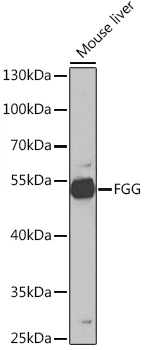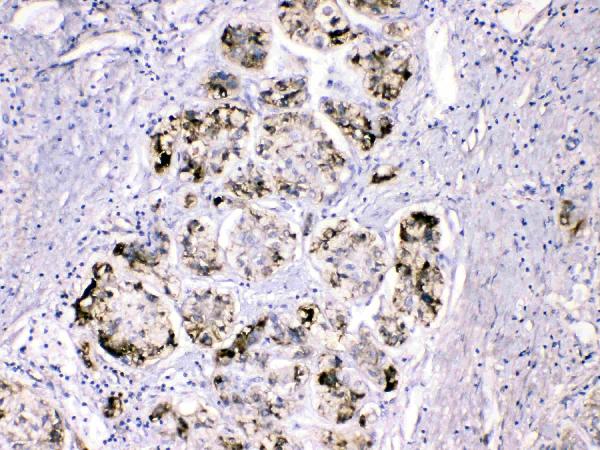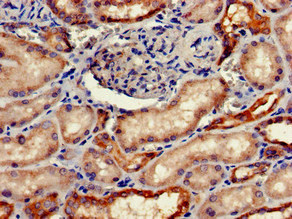![ELISA analysis of antigen using GTX60502 Fibrinogen gamma antibody [4H9]. Red : Control antigen 100ng Purple : Antigen 10ng Green : Antigen 50ng Blue : Antigen 100ng ELISA analysis of antigen using GTX60502 Fibrinogen gamma antibody [4H9]. Red : Control antigen 100ng Purple : Antigen 10ng Green : Antigen 50ng Blue : Antigen 100ng](https://www.genetex.com/upload/website/prouct_img/normal/GTX60502/GTX60502_20170912_ELISA_w_23061123_811.webp)
ELISA analysis of antigen using GTX60502 Fibrinogen gamma antibody [4H9]. Red : Control antigen 100ng Purple : Antigen 10ng Green : Antigen 50ng Blue : Antigen 100ng
Fibrinogen gamma antibody [4H9]
GTX60502
ApplicationsFlow Cytometry, ImmunoFluorescence, Western Blot, ELISA, ImmunoCytoChemistry, ImmunoHistoChemistry, ImmunoHistoChemistry Paraffin
Product group Antibodies
TargetFGG
Overview
- SupplierGeneTex
- Product NameFibrinogen gamma antibody [4H9]
- Delivery Days Customer9
- Application Supplier NoteWB: 1/500 - 1/2000. ICC/IF: 1/200 - 1/1000. IHC-P: 1/200 - 1/1000. FACS: 1/200 - 1/400. ELISA: 1/10000. *Optimal dilutions/concentrations should be determined by the researcher.Not tested in other applications.
- ApplicationsFlow Cytometry, ImmunoFluorescence, Western Blot, ELISA, ImmunoCytoChemistry, ImmunoHistoChemistry, ImmunoHistoChemistry Paraffin
- CertificationResearch Use Only
- ClonalityMonoclonal
- Clone ID4H9
- ConjugateUnconjugated
- Gene ID2266
- Target nameFGG
- Target descriptionfibrinogen gamma chain
- Target synonymsfibrinogen gamma chain; fibrinogen, gamma polypeptide; testicular tissue protein Li 70
- HostMouse
- IsotypeIgG2a
- Protein IDP02679
- Protein NameFibrinogen gamma chain
- Scientific DescriptionThe protein encoded by this gene is the gamma component of fibrinogen, a blood-borne glycoprotein comprised of three pairs of nonidentical polypeptide chains. Following vascular injury, fibrinogen is cleaved by thrombin to form fibrin which is the most abundant component of blood clots. In addition, various cleavage products of fibrinogen and fibrin regulate cell adhesion and spreading, display vasoconstrictor and chemotactic activities, and are mitogens for several cell types. Mutations in this gene lead to several disorders, including dysfibrinogenemia, hypofibrinogenemia and thrombophilia. Alternative splicing results in two transcript variants encoding different isoforms. [provided by RefSeq, Jul 2008]
- Storage Instruction-20°C or -80°C,2°C to 8°C
- UNSPSC12352203

![FACS analysis of HepG2 cells using GTX60502 Fibrinogen gamma antibody [4H9]. Blue : Fibrinogen gamma Red : negative control FACS analysis of HepG2 cells using GTX60502 Fibrinogen gamma antibody [4H9]. Blue : Fibrinogen gamma Red : negative control](https://www.genetex.com/upload/website/prouct_img/normal/GTX60502/GTX60502_20170912_FACS_w_23061123_110.webp)
![ICC/IF analysis of 3T3-L1 cells using GTX60502 Fibrinogen gamma antibody [4H9]. Green : Fibrinogen gamma Blue: DRAQ5 fluorescent DNA dye Red: Actin filaments ICC/IF analysis of 3T3-L1 cells using GTX60502 Fibrinogen gamma antibody [4H9]. Green : Fibrinogen gamma Blue: DRAQ5 fluorescent DNA dye Red: Actin filaments](https://www.genetex.com/upload/website/prouct_img/normal/GTX60502/GTX60502_20170912_ICCIF_w_23061123_191.webp)
![IHC-P analysis of liver cancer tissue using GTX60502 Fibrinogen gamma antibody [4H9]. IHC-P analysis of liver cancer tissue using GTX60502 Fibrinogen gamma antibody [4H9].](https://www.genetex.com/upload/website/prouct_img/normal/GTX60502/GTX60502_20170912_IHC-P_1_w_23061123_809.webp)
![IHC-P analysis of human cerebellum tissue using GTX60502 Fibrinogen gamma antibody [4H9]. IHC-P analysis of human cerebellum tissue using GTX60502 Fibrinogen gamma antibody [4H9].](https://www.genetex.com/upload/website/prouct_img/normal/GTX60502/GTX60502_20170912_IHC-P_w_23061123_152.webp)
![WB analysis of human Fibrinogen gamma (AA: 210-437) recombinant protein using GTX60502 Fibrinogen gamma antibody [4H9]. WB analysis of human Fibrinogen gamma (AA: 210-437) recombinant protein using GTX60502 Fibrinogen gamma antibody [4H9].](https://www.genetex.com/upload/website/prouct_img/normal/GTX60502/GTX60502_20170912_WB_w_23061123_796.webp)






